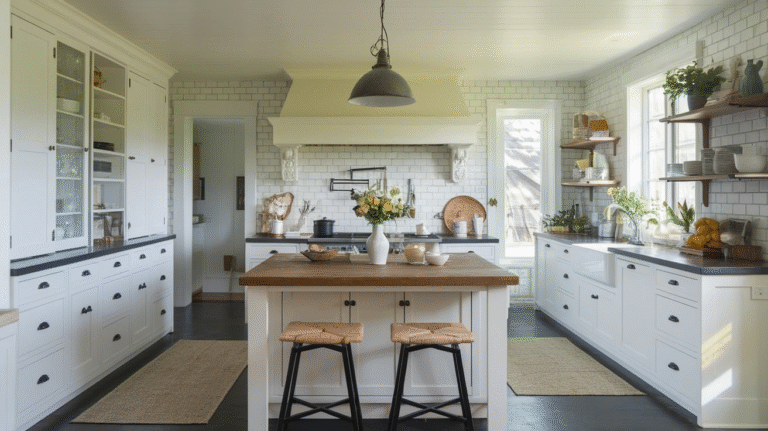21 Best Pantry Organization Ideas That Actually Work
A messy pantry is like a black hole—it swallows your snacks, hoards your pasta, and somehow makes that jar of peanut butter vanish right when you need it most.
If you’ve ever found yourself buying duplicates of spices you already own (but couldn’t find), you’re not alone.
Studies show that the average household wastes 25% of purchased food simply because of poor storage and organization. That’s money, space, and sanity slipping through your fingers.
1. Start With a Ruthless Declutter
Before buying fancy bins or labels, the real magic begins with decluttering. Open your pantry and take everything out—yes, everything.
Group items into three piles: keep, donate, and toss. You’d be surprised how many expired cans are sitting in the back like forgotten relics of grocery trips past.
According to the USDA, the average family of four throws away $1,500 worth of food annually. A big part of this is simply because items get buried and forgotten. Decluttering helps you save both space and money.
2. Group Like With Like
Think of your pantry as a library. Books (or in this case, food) need to be grouped by category to make sense. Place all pastas together, cereals together, snacks in one area, canned goods in another.
When similar items live side by side, you’ll instantly see when something is running low.
I once had three different shelves for snacks (don’t ask why), and my kids would raid the “wrong” one every time. Once I grouped everything into a single snack zone, not only did I save space, but I also stopped overbuying potato chips.
3. Use Clear Containers for Staples
Here’s the thing: bags of flour, sugar, or rice are not only floppy and messy, they’re also hard to stack. By transferring pantry staples into clear, airtight containers, you solve two problems—visibility and freshness.
A study by Kitchen Cabinet Kings found that 72% of people eat healthier when they can clearly see their food options. Seeing your lentils, oats, or quinoa neatly lined up also reduces food waste because nothing gets lost.
Pro tip: Choose square or rectangular containers. They maximize space better than round ones.
4. Label Everything Like a Pro
Labels aren’t just about aesthetics; they’re about function. A labeled container instantly tells you whether it’s powdered sugar or flour (because let’s be real, in a sleepy morning haze, guessing wrong can ruin pancakes).
Invest in a label maker or even just chalkboard labels. It’s a small step that creates big clarity. Plus, it makes family members more likely to put things back where they belong.
5. Install Adjustable Shelving
Your pantry isn’t a one-size-fits-all space, so why should your shelves be? Adjustable shelving allows you to customize the height to fit tall cereal boxes, short jars, or bulky appliances.
This flexibility ensures that no vertical space is wasted. A study on storage solutions showed that customizable shelving increases usable space by up to 30% compared to fixed shelves.
6. Add Lazy Susans for Small Items
If spices and condiments are disappearing into the abyss, a Lazy Susan is your best friend. These rotating trays make everything accessible with a simple spin.
I once lost a jar of honey for six months—it had rolled to the back and vanished. With a Lazy Susan, honey (and every other condiment) is always just a twirl away.
7. Create Zones for Meal Types
One of my favorite hacks is to organize the pantry by meal type. Breakfast zone: cereals, oats, pancake mix. Pasta night zone: noodles, sauces, garlic bread mix. Snack zone: chips, bars, dried fruit.
This not only streamlines cooking but also makes grocery list prep much easier. Imagine your pantry like a well-structured grocery store—you know exactly where to find what you need.
8. Use Door Racks for Extra Storage
If you’re not using the back of your pantry door, you’re missing prime real estate. Install a door rack for spices, small jars, or snack packs.
Door racks can increase storage by up to 20% without adding bulk. They’re especially helpful for small kitchens where every inch counts.
9. Stack Bins and Baskets
When in doubt, stack it out. Bins and baskets are lifesavers for corralling loose items like snack packs, juice boxes, or baking supplies. Label the front, stack vertically, and suddenly your messy pile becomes a neat tower of organization.
I keep a basket labeled “Kid Snacks” on a low shelf—this has reduced the “Mom, where are the cookies?” cries by at least 70%.
10. Invest in a Spice Organizer
Nothing clutters a pantry faster than dozens of spice jars rolling around. Invest in a spice rack, drawer insert, or tiered shelf. Alphabetize them if you’re feeling ambitious.
According to Statista, the global spice market is worth $37 billion, and chances are, you own at least 20 different jars. Organizing them properly saves time and prevents duplicates.
11. Use Risers for Cans and Jars
Canned goods often end up stacked in unstable towers. A better solution is tiered risers, which let you see everything at once. No more finding five cans of beans hidden behind soup.
Think of risers as stadium seating for your pantry—everyone gets a front-row view.
12. Add Pull-Out Drawers
If your pantry feels like a dark cave, pull-out drawers are the flashlight you need. They bring hidden items to the front, reducing forgotten food and frustration.
This is especially useful for deep lower shelves, where items tend to disappear into the shadows.
13. Keep Snacks at Eye Level
Want to reduce unhealthy snacking? Place chips and cookies higher up, out of sight. Want kids to be more independent? Put their snacks at their eye level.
Psychologists call this choice architecture—where you place items influences the choices people make. A Cornell University study found that simply placing fruit at eye level increased consumption by 30%.
14. Store Baking Supplies in a Baking Zone
Baking can get messy fast if your sugar, flour, and sprinkles live in different corners of the pantry. Create a dedicated baking zone with all your essentials in one place.
I once had a baking marathon with my niece, and we wasted half the afternoon just hunting for the baking powder. Now, with a baking basket, everything is ready to go.
15. Rotate Items FIFO Style
Adopt the First In, First Out (FIFO) method used by restaurants. Place newer groceries behind older ones, so you use up what you bought first.
This simple system slashes waste. According to Feeding America, 119 billion pounds of food is wasted annually in the U.S. FIFO is a small but powerful way to fight that.
16. Use Vacuum-Sealed Bags for Bulk Items
Buying in bulk saves money, but storing bulk items is tricky. Enter vacuum-sealed bags. They reduce volume, extend shelf life, and keep pests out.
Rice, beans, or nuts stay fresher for months, and you free up precious shelf space.
17. Add Lighting Inside the Pantry
A dark pantry is an invitation for chaos. Add motion-sensor LED lights so you can actually see what you have.
Lighting doesn’t just make things visible; it makes organization feel intentional. Plus, it saves you from mistaking powdered sugar for flour in dim light (yes, I’ve been there).
18. Designate a Grab-and-Go Basket
Life gets busy. A grab-and-go basket filled with protein bars, trail mix, or juice boxes makes mornings smoother. Just grab, toss into your bag, and head out the door.
It’s also a sanity-saver for road trips—I keep a basket ready so packing snacks is effortless.
19. Store Oils and Vinegars in a Tray
Bottles of olive oil, vinegar, and soy sauce tend to drip, leaving sticky rings on shelves. Solve this by placing them on a tray. If spills happen, you just rinse the tray instead of scrubbing the entire shelf.
Simple, effective, and elegant.
20. Seasonal Swap-Outs
Pantries, like wardrobes, benefit from seasonal swaps. In winter, hot cocoa, soups, and baking supplies take center stage. In summer, lemonade mix, barbecue rubs, and picnic snacks move forward.
Rotating items seasonally keeps your pantry relevant and uncluttered.
21. Make It Family-Friendly
Finally, remember you’re not the only one using the pantry. Create zones that are family-friendly. A kid snack shelf, a partner’s tea corner, or a dog treat bin makes the pantry a shared, stress-free space.
When everyone has their own “territory,” the pantry feels less like a battleground and more like a team project.
Conclusion on 21 Best Pantry Organisation Ideas
A pantry isn’t just storage—it’s the command center of your kitchen. When it’s chaotic, cooking feels stressful, and food waste skyrockets. But with smart organization, your pantry becomes a place of calm efficiency.
By decluttering, using clear containers, creating zones, and adopting tricks like FIFO and Lazy Susans, you can reclaim your pantry from the jaws of chaos. Remember, the goal isn’t Pinterest perfection—it’s functionality that works for your real life.
Every household is different, so start small: maybe with labels, maybe with a snack basket. Slowly, layer in more systems until your pantry feels like a well-oiled machine. And the best part? You’ll save money, waste less, and finally stop losing that honey jar in the shadows.





